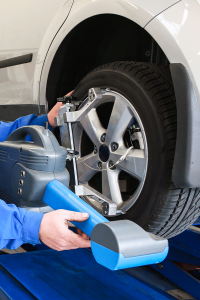
Potholes can be a hazard to the vehicle. While the tires and wheels are easy to visually inspect, there could also be damage to other areas of your vehicle. The suspension, steering, and alignment systems can all become damaged as well. It is important to schedule an appointment to bring the vehicle in so it can be inspected after hitting a pothole.
Potholes occur during the spring months when the water permeates the pavement. This is typically from a crack in the road due to heavy wear and tear of the traffic. This will then cause it to soften the soil below it and it will then create a depression into the surface of the road. The freezing and thawing weather cycles can accelerate this process. After a few cycles, the road will have a pothole in it. If there is flooding or rain, this can disguise where the potholes are. That is why it is important to make sure to approach water puddles carefully. Water can hide how deep the puddle or pothole may actually be.
By hitting a pothole, it may cause damage to the tires on the vehicle. It could cause them to have low tire pressure, dent the rim of the tire, or produce bulges or blisters on the sidewalls. While these issues can be visible, it is always recommended to bring the vehicle in for an inspection. Depending how serious these issues are, it could cause a safety hazard when you drive. Bring the vehicle in and we can inspect the parts and components of the vehicle. If there is an issue, we can help to make you aware of it. This can get you back to driving a safe and reliable vehicle again. It can also help provide a pleasant ride for you and your passengers. It is also recommended to have the steering and suspension systems checked at least once a year.
Another sign of damage from hitting potholes is if the vehicle pulls in one direction or another. This can be especially noticeable when driving in a straight line. The tires may no longer be aligned properly and cause an issue when driving. Having the vehicle pull in a direction may also indicate an issue with how the tires are wearing. Make sure to bring the vehicle in and we can inspect it for the issue that causes it to pull. It is also advised to go to inspections regularly, so we can ensure the vehicle is in top condition for you. If you are not sure how often to bring the vehicle in, contact us and we can recommend the schedule for you.